David T. Allen's Blog, page 8
February 14, 2015
Truck Themed Hipster Dance Party
Sometimes, you just gotta leave the house. For me, that’s normally due to a desperate need of groceries. But last night, I left for an entirely foreign purpose: Hipster Dance Party.
My good friend and designer, Lana, invited me. Since I had worked exclusively on editing and writing for about twelve hours a day for many days, it seemed like a good time to step away from the computer and try to remember that a world exists outside of Bitlather Chronicles.
Hipster Dance Party is an event held at the Brillo Box, and last night’s theme was monster trucks. Lest you think Hipster Dance Party would be an apathetic affair, some photographic evidence to the contrary:


That giant truck cut-out had random stuff projected on it: the desert at night, grumpy cat, video games, videos of monster trucks. I’m not much of a dancer, so this provided entertainment while I broke out the same two moves all night.

Yesterday, being the day before Valentine’s Day, someone was handing out valentines. She wore a hood, like, a hood unconnected to her shirt, with monster trucks on it and large chains weighing it down. She was so dedicated to the theme, even the valentines were monster truck related. Thanks for the valentine, Lazer Crunk!
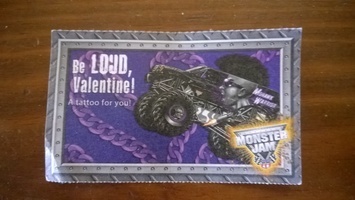
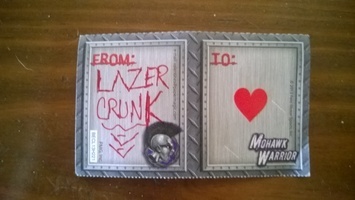
Some other fun tidbits from last night: the lights on the walls all had googly eyes, and the hand stamp they used reads Those who have eyes are divine.

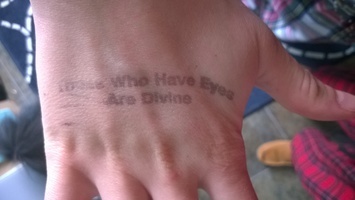
February 11, 2015
Blog Design Tweaks
I’m not a designer. Not even close. So when I built this site, I just used bootstrap, kept it simple, and focused on functionality over aesthetic. But it’s time to make a few changes. I’m not sure how much these changes will impact viewers, but I hope sharing this information will help you scrutinize your own blog.
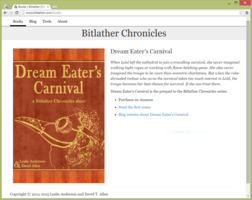
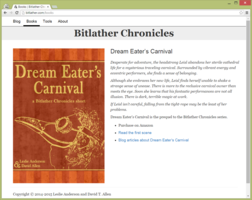
First, the root page, www.bitlather.com, now shows the blog instead of books. I think seeing a list of blog articles is a better first impression. If a visitor came for the books, it’s easy to get there. Also, we advertise the most recent book at the top of the blog page.
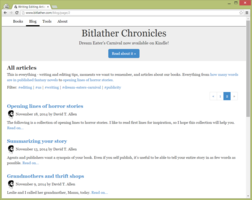
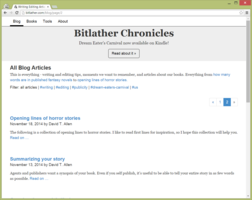
Speaking of that advertisement, I changed the button so it fits in better with the design. I think the big blue button was jarring.
The site’s title, Bitlather Chronicles, is now bolder. I might change my mind on that one and put it back.
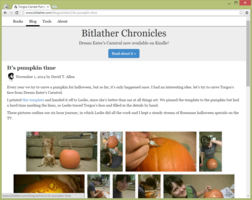
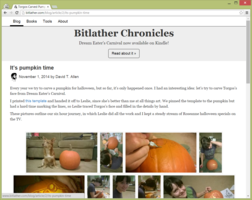
Header tags, blog dates, and links are now a sans serif font so they pop a bit more. I noticed other blogs switch between using a serif and sans-serif font for headers and content. Looking back, I think using a serif font for everything looked messy.
Speaking of messy, I removed the author icons when listing blog articles. They felt like clutter. They also didn’t work well on cell phone screens.
I also decided to switch to title case in header tags.
The currently selected filter in lists of blog articles persists. Before it went away, and I think that made the list a bit jarring when switching between tags.
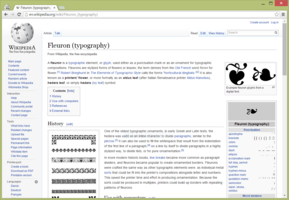

I’m considering changing it so headers have serifs and content doesn’t, since small sans-serif fonts seem clearer than small serif fonts. That’s how wikipedia does it. I’m not trying to astound the world with my design skills, and I assume wikipedia has thought hard about their fonts, so borrowing from them isn’t a bad idea.
February 1, 2015
Sprint 2: February Edition
Leslie and I are taking an “agile” approach to writing this year. I’ve borrowed a few ideas from software development, but I won’t bore you with software dev … in this article.
We made a board in January that contains all of our month’s and year’s goals. Let’s see how January went:

Retrospective
We agreed on January 1 that Leslie would focus on the new book, Echo Chamber Heist, while I would finish and publish Dream Eater’s Carnival.
Leslie crushed her goals (pink) but I didn’t do so well (yellow). It’s important to analyze what happened.
Leslie
Let’s focus on Leslie’s successes first. She only missed three items: check the PO box works and submit two chapters to our writing community. That’s because we pivoted a few weeks into January.
We received an unexpected number of critiques and were invited into an intense critique group. Because we already had a lot of input (well over 100 chapter critiques), we decided to update the posted chapters instead of posting new content. This helps us get feedback on changes sooner and should reduce the time spent editing later.
Even though a few items were unfinished, Leslie more than made up for it with edits. We added pink slips to the “done” column for chapters she edited.
Dave
We asked a mixture of new readers and old critiquers to beta read Dream Eater’s Carnival. The results were positive, but everyone highlighted a few weaknesses.
I had to be careful with changes. It’s easy to introduce flaws this late in the game.
It wasn’t until we passed the changes to each other a few times that we realized something awful: we disagreed on how modern day people viewed the history of cathedrals.
It was difficult to handle, at first. Both of us were stubborn – me especially – and I was frustrated that we weren’t actually finished. I took a long walk in the snow (because that’s what I do on Sundays) and, when I returned, I realized we could still accomplish all future goals related to the cathedrals regardless of which approach we took.
But still, neither of us were willing to give in on who was correct.
So we sent both snippets to our critiquing chums and stamped it with URGENT. These wonderful people finished in a day, but yet again we had bad news: none of them agreed. What one person loved, another person hated.
We analyzed their input and found some middle ground we both could agree on.
So, I didn’t publish anything – and all of my goals were blocked because they relied on publishing Dream Eater’s Carnival.
Takeaways
The board keeps us focused, motivated, and happy. At a glance, we know what we need to do and what we’ve already accomplished. In the past, it felt like things were never getting done, even if we worked on the book for hours a day.
Even though Leslie and I had a heavy load at work this month, we feel more productive with our writing goals than ever before.
It’s difficult to figure out when a work is good enough to publish. Almost every book has flaws, and at some point, you have to publish and move on with your life. And boy, were we ready to move on. But when all of our beta readers flagged the same issues, we had to fix it.
Adding a few hundred words to a nearly completed book is much harder than writing brand new chapters.
Editing for months at a time is soul sucking. Having Leslie focus on new content made us happy. We should always balance writing with editing to reduce time spent editing a finished book.
Early stage critiques are invaluable. Dream Eater’s Carnival would have went smoother if we had found a good writing community sooner.
February’s Board
We moved all finished tasks into a quart jar and placed it in our cabinet, next to the lentils and quinoa.
Then, we reordered our year’s goals. It’s important to read the long-term goals to stay focused on how this month gets us closer to completion.
Finally, we added our new tasks. We decided to use different colors from January so our eye would be drawn to incomplete tasks.
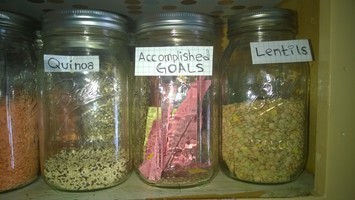

Bonus Content
During this process, our dogs took turns licking an empty jar of peanut butter. I added pictures for your amusement:
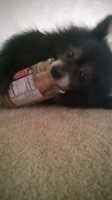


February Goals & Sprint 1 Retrospective
Leslie and I are taking an “agile” approach to writing this year. I’ve borrowed a few ideas from software development, but I won’t bore you with software dev … in this article.
We made a board in January that contains all of our month’s and year’s goals. Let’s see how January went:

Retrospective
We agreed on January 1 that Leslie would focus on the new book, Echo Chamber Heist, while I would finish and publish Dream Eater’s Carnival.
Leslie crushed her goals (pink) but I didn’t do so well (yellow). It’s important to analyze what happened.
Leslie
Let’s focus on Leslie’s successes first. She only missed three items: check the PO box works and submit two chapters to our writing community. That’s because we pivoted a few weeks into January.
We received an unexpected number of critiques and were invited into an intense critique group. Because we already had a lot of input (well over 100 chapter critiques), we decided to update the posted chapters instead of posting new content. This helps us get feedback on changes sooner and should reduce the time spent editing later.
Even though a few items were unfinished, Leslie more than made up for it with edits. We added pink slips to the “done” column for chapters she edited.
Dave
We asked a mixture of new readers and old critiquers to beta read Dream Eater’s Carnival. The results were positive, but everyone highlighted a few weaknesses.
I had to be careful with changes. It’s easy to introduce flaws this late in the game.
It wasn’t until we passed the changes to each other a few times that we realized something awful: we disagreed on how modern day people viewed the history of cathedrals.
It was difficult to handle, at first. Both of us were stubborn – me especially – and I was frustrated that we weren’t actually finished. I took a long walk in the snow (because that’s what I do on Sundays) and, when I returned, I realized we could still accomplish all future goals related to the cathedrals regardless of which approach we took.
But still, neither of us were willing to give in on who was correct.
So we sent both snippets to our critiquing chums and stamped it with URGENT. These wonderful people finished in a day, but yet again we had bad news: none of them agreed. What one person loved, another person hated.
We analyzed their input and found some middle ground we both could agree on.
So, I didn’t publish anything – and all of my goals were blocked because they relied on publishing Dream Eater’s Carnival.
Takeaways
The board keeps us focused, motivated, and happy. At a glance, we know what we need to do and what we’ve already accomplished. In the past, it felt like things were never getting done, even if we worked on the book for hours a day.
Even though Leslie and I had a heavy load at work this month, we feel more productive with our writing goals than ever before.
It’s difficult to figure out when a work is good enough to publish. Almost every book has flaws, and at some point, you have to publish and move on with your life. And boy, were we ready to move on. But when all of our beta readers flagged the same issues, we had to fix it.
Adding a few hundred words to a nearly completed book is much harder than writing brand new chapters.
Editing for months at a time is soul sucking. Having Leslie focus on new content made us happy. We should always balance writing with editing to reduce time spent editing a finished book.
Early stage critiques are invaluable. Dream Eater’s Carnival would have went smoother if we had found a good writing community sooner.
February’s Board
We moved all finished tasks into a quart jar and placed it in our cabinet, next to the lentils and quinoa.
Then, we reordered our year’s goals. It’s important to read the long-term goals to stay focused on how this month gets us closer to completion.
Finally, we added our new tasks. We decided to use different colors from January so our eye would be drawn to incomplete tasks.


Bonus Content
During this process, our dogs took turns licking an empty jar of peanut butter. I added pictures for your amusement:



January 24, 2015
Game Masters in Pittsburgh
Today we dropped into Game Masters. Our friend Garett had pointed out the place on New Years, when we were en route to brunch. We love board games, so I’ve been waiting for a free day to check it out.

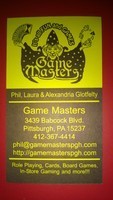
We just wanted to drop in and look around, but we ended up talking with the owner, Phil, for over an hour.
Phil likes to tell jokes. He pointed at one game, Scoville, and told us about one of his tweets. I found it when I got home:
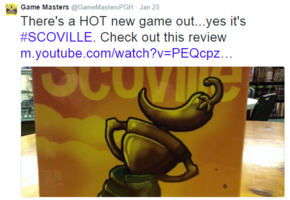
Anyways, we hadn’t planned on buying anything, but a few things caught our eye.
His daughter talked at length about Love Letter. As they described it, I realized it was the same premise as Munchkin Loot Letter, which my friend Mike Springer had introduced to me at GASP (Gaming Association of Southwestern Pennsylvania). I’ve wanted Loot Letter for a while now, so I had to pick it up.
Second was Forbidden Desert. The steampunk aesthetic was too hard to pass up. Publisher's game description:
Gear up for a thrilling adventure to recover a legendary flying machine buried deep in the ruins of an ancient desert city. You’ll need to coordinate with your teammates and use every available resource if you hope to survive the scorching heat and relentless sandstorm. Find the flying machine and escape before you all become permanent artifacts of the forbidden desert!
In Forbidden Desert, a thematic sequel to Forbidden Island, players take on the roles of brave adventurers who must throw caution to the wind and survive both blistering heat and blustering sand in order to recover a legendary flying machine buried under an ancient desert city. While featuring cooperative gameplay similar to Forbidden Island, Forbidden Desert is a fresh new game based around an innovative set of mechanisms, such as an ever-shifting board, individual resource management, and a unique method for locating the flying machine parts.
Usually I play aggressively with Leslie, so I think she appreciated that the game was co-op against the board. I also prefer games that keep everyone involved until it’s over, since it’s no fun to sit out when you lose.
Finally, a small pendant caught my eye. It’s a game counter, which I don’t have any use for, but I loved the aesthetic.
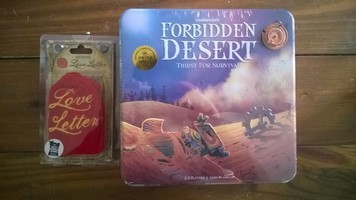

If you’re in the Pittsburgh area, check them out at http://www.gamemasterspgh.com/
January 20, 2015
You know, this bosu ball kind of looks like a boob.
I frankensteined myself standing desk from things I already owned: a shoe rack, a backgammon table, and a coffee table that I’ve been using diligently for all of my most important projects ever since I was about six years old.
It was glorious. But it was kind of static. Thus, I added a chaotic element: the bosu ball!


It’s supposedly good for my joints and burns more calories and stuff. That’s cool and all, but what I really enjoy is that it’s like standing on a tiny trampoline. If I’m standing at my desk, I’m almost guaranteed to be bouncing. If a really good song comes on, I’m liable to bounce myself right off.
January 16, 2015
How to Make Kimchi
I’m not going to get into the whys of making kimchi. It’s tasty, it’s healthy, it’s cheap, it doesn’t go bad, and an hour of your time can feed you for weeks. Those are all qualities an author should be able to appreciate.
Ingredients:
2 pounds of nappa cabbage, chopped
1-2 daikon radish, sliced thin
2-4 carrots, sliced
1 onion (yellow or red), sliced
2-5 cloves garlic, minced or pressed
1 tablespoon or more grated garlic
Hot peppers (Optional, though I recommend. I use 2-3 seeded Thai chili peppers.)
4 tablespoons (or more) sea salt
4 cups (or more) water, preferably non-chlorinated.
Time required:
Active: 1-2 hours (depending on how good at chopping you are.)
Inactive: 1-2 weeks (depending on how warm your house is.)
Prepare the nappa cabbage, daikon, carrots, and onions.


Put them in a large pot or bowl and mix them up. Combine the salt and water, making sure the salt is largely dissolved. Pour the salt water over the vegetables, and weigh down the vegetables so that they are covered with the water. The vegetables will crunch down a little bit, so initially they might not be covered. If you think you need more salt water to properly cover the vegetables, add more.
Let them soak in the salt water for at least two hours. I prefer longer than that.
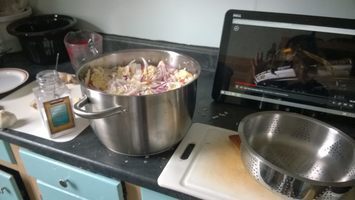

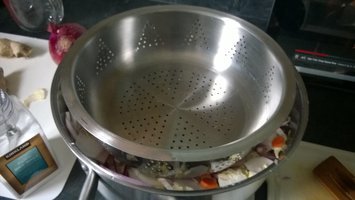
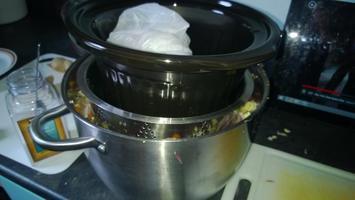
While soaking, you can prepare the garlic, ginger, and peppers.


Drain the vegetables, reserving some of the liquid. A few cups should be plenty.
Taste the vegetables. They should taste salty, but not unpleasantly so. If they’re way too salty, soak them in normal water for a few minutes and drain.
Mix together the vegetables with the garlic, ginger, and peppers. Be sure to mix well.
Pack tightly into … something. I primarily use a rock-sugar jar from Teavana. It’s the perfect size. Unless you have need of a lot of German rock sugar, I suggest using mason jars or crocks. (I’ve used both.)



If you’re in the US, you can mostly likely get mason jars from your local hardware store (I hit up the True Value near me). If you have a crockpot, you can use the crock from that. If you don’t (or can’t spare your crock for a week or two), you can often buy standalone crocks from thrift stores for really cheap.
You want to pack the vegetables into whatever container you choose as tight as you can, then put some sort of weight on the top to ensure that the liquid level is above the vegetables.
If fermenting in a jar, often times all you need is a glass.
If fermenting in a crock, you’ll likely need something bigger and heavier. Like, a plate of the perfect diameter, a Tupperware to sit atop the jar, and something heavy to go in that Tupperware to weigh everything down.
If you can’t seem to weigh it down enough for the liquid in the vegetables to cover everything, you can add some of the reserved soaking liquid.
Set it off to the side somewhere that it won’t get too cold. Cover with a tea towel to make sure that bugs can’t get in. Then just let it sit for a week or two. You can taste it daily to see how it progresses and determine what level of fermenting you prefer. Just make sure the liquid level is above the vegetables. Depending on how long you soaked your vegetables, you may have air pockets develop in the vegetables. Stirring every day or so will allow this air to escape, which keep your veggies fermenting properly.
I serve kimchi with short-grain rice, hardboiled eggs, toasted seaweed, and toasted sesame seeds. That means that if I’m in the middle of a crazy deadline I can just throw rice in the rice cooker, eggs on to boil, and I can have a healthy, tasty meal with little time spent.
Not to mention, it’s cheap! That pot in the picture is an 11 quart pot. That makes a ton of kimchi.
I recommend shopping at your local Asian market to find similar prices. I can get daikon and nappa cabbage from high-end supermarkets, but for double or triple the cost of them at the Asian market.
Cost for my most recent batch:
Nappa Cabbage (1): $2.88
Red Onions (2): $2.61
Daikon radish (3): $2.71
It’s a little bit harder to calculate the carrots, ginger, and garlic as I buy them in bulk. Also, a bag of the peppers costs somewhere around $1.50 for around 40 peppers, and I’m too lazy to calculate how much each pepper costs. Let’s pretend that it costs about $3.00 across the board. That’s including sea salt and the use of the RO water. If anything, I think that’s overestimating.
That leaves us with a total of: $11.20. For four quarts of kimchi. Each quart lasts us about a week, at one meal per day. That’s $1.40 dollars per person per week. Or $0.20 per meal. Add in the eggs, rice, seaweed, and sesame seeds, and you’ve still got a cheap meal.
January 12, 2015
Feminine Obscenities
Ever hear the phrase “kill your darlings?” Usually I’m fine with letting them go, but sometimes they crop up in unexpected ways.
Here is an excerpt from one of our revisions of Dream Eater’s Carnival:
“Young miss, this is a private space!” he yelled, his voice like gravel. He lurched to his feet, causing the razor to bite into his face. The woman shrieked feminine obscenities as she crashed to the ground.
A majority of beta readers highlighted it and asked what we meant. I thought it was a clever way to reinforce language and culture – although our characters all speaks English, men and women had different cuss words. I would have also accepted if readers thought it was a word that was offensive when uttered by a woman, but no one would raise an eyebrow if a man said it.
I dug in my heels on this one, and we had a mix set of responses:
♀: Ha ha, just gets more bizarre, as it should.
(same reader, second pass…) This made my mind wander off into what female obscenities would sound like, how they would be different from male obscenities… in other words, I don't think you need ‘feminine’
♂: Feminine obscenities? What are those? Have I missed out on a whole catalogue of obscenities my whole life?
♂: Are ‘feminine obscenities’ different to male ones? Or has she said them in a feminine way?
♀: Not come across this term before, I can guess what it means
♀: LOL, there’s a difference?
♀: What does this mean?
(same reader, second pass…) I’m still trying to figure out what this means
♂: What does that mean? She yelled names for female body parts?
♀: Also, what are feminine obscenities? Do women have particular curses or something?
It wasn’t until this one, one that we received weeks after everyone else had finished looking over our story, that I gave up (with a little chuckle):
♀: I’d love to know what constitutes feminine obscenities. “Fucking fairy farts” or similar ;)
This is why beta readers are so important. I would like to smack my former self with a rolled up newspaper for being so stubborn.
January 6, 2015
Critiques: “I Need to Know More About …”
When swapping critiques, there are times when a critic might say, “I need to know more about …” Before you edit to answer their question, you have to figure out: do they need to know more, or do they want to know more?
Don’t be afraid to ask the critic to clarify. If you’ve written something really good, they might be expressing excitement.
For example, I wish there were more scenes with the hellhound from Good Omens. The hellhound is my favorite character, but it only has a minor focus.
If I had critiqued Good Omens, I might have said I needed more scenes with the dog. But really, the few pages that feature the hellhound are golden, and adding more might have degraded the story.
Some of our critiquers wanted the mime from Dream Eater’s Carnival to be in more scenes. Mimes are interesting because they can’t communicate with words. But, if they stay too long, their convoluted method of communication would bog down the story. The mime could speak – but too much dialog ruins the effect.
When you critique others’ work, make it clear when lack of information detracts from the story and when you just want to know more.
January 1, 2015
New Years & Project Management: Make Board
“The secret of getting ahead is getting started. The secret of getting started is breaking your complex overwhelming tasks into small manageable tasks, and then starting on the first one.”
— Mark Twain
Our wonderful friends, Garett and Lauren, visited for New Year’s Eve. It’s become a tradition; all of us want something low key after the holiday rush. Most of our evening was spent playing Blokus and watching Drop Dead Gorgeous.

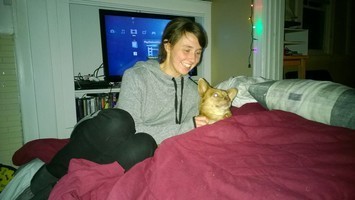
And lo, 2015 began. Not with a bang, but with a diligent and quiet brainstorming session. And a few corkboards.
We came up with our year goals, then decided what first steps we needed to take, assigned them, and put them on the board. One important aspect of this is the “done” category. There are few things more satisfying than seeing what all you’ve finished.
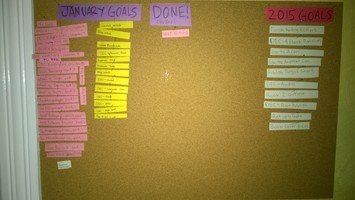

At the end of the month we’ll assess how we did on our goals. Did we finish them all? In not, why? Then we’ll come up with a new set of goals based on what we accomplished and what we learned. Repeat this twelve times, and we’ll have had a successful year.
Bonus: Keep your “done” slips at the end of the month and put them in a container. At the end of the year, dump them all onto the floor and roll around in them. Too much?



